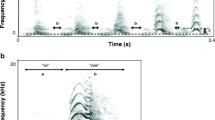Abstract
Call-timing mechanisms among anuran males calling within choruses are frequent, and previous studies have indicated that midwife toad females respond preferentially to these mechanisms. The results of multi-speaker tests performed here with midwife toads suggest that the temporal order of male calls within a dense chorus can determine the ability of females to locate the most attractive calls (in this instance the low-frequency calls emitted by larger males). When call emission was regular in the multi-speaker tests, most females chose the most attractive option (i.e., the speaker emitting the lower-frequency call). When call emission was not regular, however, most females failed to reach the most attractive option, selecting the speaker that emitted immediately after that emitting the most attractive call. These results support the idea that there may be benefits for smaller males that emit their less attractive calls close to those of larger, more attractive males in dense choruses. Less attractive males could exploit the attractiveness of nearby larger males calls by alternating their calls in an unordered sequence to reach receptive females.


Similar content being viewed by others
References
Bosch J, Márquez R (2000) Acoustical interference in the advertisement calls of the midwife toads (Alytes obstetricans and A. cisternasii). Behaviour 137:249–263
Bosch J, Márquez R (2001) Call timing in male–male acoustical interactions and female choice in the midwife toad Alytes obstetricans. Copeia 2001:169–177
Bosch J, Márquez R (2002) Female preference function related to precedence effect in an amphibian anuran (Alytes cisternasii). Tests with non-overlapping calls. Behav Ecol 13:149–153
Bosch J, Rand AS, Ryan MJ (2000) Signal variation and call preferences for the whine frequency in the túngara frog, Physalaemus pustulosus. Behav Ecol Sociobiol 49:62–66
Bosch J, Márquez R, Boyero L (2003) Behavioural patterns, preference and motivation of female midwife toads during phonotaxis tests. J Ethol 21:61–66
Gerhardt HC (1987) Evolutionary and neurobiological implications of selective phonotaxis in the green treefrog, Hyla cinerea. Anim Behav 35:1479–1489
Gerhardt HC (1994) The evolution of vocalization in frogs and toads. Ann Rev Ecol Syst 25:293–324
Gerhardt HC, Schul J (1999) A quantitative analysis of behavioral selectivity for pulse rise-time in the gray treefrog. J Comp Physiol A 185:33–40
Greenfield MD (1994) Cooperation and conflict in the evolution of signal interactions. Annu Rev Ecol Syst 25:97–126
Greenfield MD, Tourtellot MK, Snedden WA (1997) Precedence effect and the evolution of chorusing. Proc R Soc Lon B 264:1335–1361
Halliday TR, Tejedo M (1995) Intrasexual selection and alternative mating behaviour. In: Heatwole H, Sullivan BK (eds) Amphibian biology, vol. 2, Social behaviour. Surrey Beatty, Sydney, pp 419–468
Jennions MD, Petrie M (1997) Variation in mate choice and mating preferences: a review of causes and consequences. Biol Rev 72:283–327
Klump GM, Gerhardt HC (1992) Mechanisms and function of call-timing in male–male interactions in frogs. In: McGregor PK (ed) Playback and studies of animal communication. Plenum, New York, pp 153–174
Márquez R (1993) Male reproductive success in two midwife toads (Alytes obstetricans and A. cisternasii). Behav Ecol Sociobiol 32:283–291
Márquez R (1995) Female choice in the midwife toads (Alytes obstetricans and A. cisternasii). Behaviour 132:151–161
Márquez R, Bosch J (1995) Advertisement calls of the midwife toads Alytes (Amphibia, Anura, Discoglossidae) in continental Spain. J Zool Syst Evol Res 33:185–192
Márquez R, Bosch J (1997) Female preference in complex acoustical environments in the midwife toads Alytes obstetricans and Alytes cisternasii. Behav Ecol 8:588–594
Márquez R, Bosch J (2001) Communication and mating in the midwife toads (Alytes obstetricans and Alytes cisternasii). In: Ryan MJ (ed) Anuran communication. Smithsonian Institution Press, Washington, pp 220–231
Márquez R, Verrell P (1991) The courtship and mating of the Iberian midwife toad, Alytes cisternasii (Amphibia, Anura, Discoglossidae). J Zool 225:125–139
Ryan MJ (1991) Sexual selection and communication in frogs: some recent advances. Trends Ecol Evol 6:351–354
Ryan MJ (2001) Anuran communication. Smithsonian Institution Press, Washington
Schwartz JJ (1987) The function of call alternation in anuran amphibians: A test of three hypotheses. Evolution 41:461–471
Telford SD, Dyson ML, Passmore NI (1989) Mate choice occurs only in small choruses of painted reed frogs Hyperolius marmoratus. Bioacoustics 2:47–53
Wells KD (1977) The social behavior of anuran amphibians. Anim Behav 25:666–693
Wilczynski W, Rand AS, Ryan MJ (1999) Female preferences for temporal order of call components in the túngara frog: a Bayesian analysis. Anim Behav 58:841–851
Zar JH (1996) Biostatistical analysis. Prentice Hall, New Jersey
Acknowledgements
Rafael Márquez and Gema Solís provided useful comments on different versions of the manuscript. The first author is supported by the Ramón y Cajal program from the Ministerio de Educación y Cultura (Spain). This work was funded by the project BOS2003-01413 (MCYT; PI: J. Bosch). The Agencia de Medio Ambiente of Junta de Extremadura extended permits for fieldwork. All animal experimentation was conducted in accordance with the legal standards of Spain.
Author information
Authors and Affiliations
Corresponding author
About this article
Cite this article
Bosch, J., Boyero, L. Female Iberian midwife toads (Alytes cisternasii) use call order to reach particular males in dense choruses. J Ethol 24, 291–295 (2006). https://doi.org/10.1007/s10164-005-0191-1
Received:
Accepted:
Published:
Issue Date:
DOI: https://doi.org/10.1007/s10164-005-0191-1




